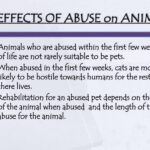In an age where communication transcends barriers and information flows like a tempest, social media platforms serve as modern-day town squares, echoing with the voices of myriad advocates. Among them, animal rights activists wield the power of the digital narrative to raise awareness of the scourge of animal cruelty. But how does posting about this grave issue on social media catalyze meaningful change? The metamorphosis of awareness into action can be likened to the ripple effect of a dropped stone in a placid pond, where every post resonates far beyond its origin, inspiring collective societal reformation.
First and foremost, social media acts as a conduit for information dissemination. Traditional media outlets often filter content through a convoluted lens, presenting a sanitized version of reality. In stark contrast, social media democratizes the narrative; it enables individuals to share raw, unfiltered images and stories that evoke emotional responses. An evocative photograph of a malnourished animal, or a heart-wrenching video of rescue missions, can pierce through the apathy of viewers. This emotional provocation creates a visceral connection that transcends screens, igniting outrage and empathy alike. Every post becomes a call to arms, demanding that followers engage in the discourse surrounding animal welfare.
Furthermore, viral posts can produce an exponential amplification of awareness. With platforms like Instagram and Facebook allowing users to share content instantly, a singular impactful image can traverse vast distances within moments. Imagine a wildfire; it begins as a tiny spark but has the potential to engulf an entire forest. Similarly, one well-crafted story of animal cruelty can inspire millions, urging them to join the fight against such atrocities. The captivating nature of visuals, coupled with poignant narratives, prompts audiences not only to absorb the information but also to share it; contagion ensues, and the dialogue proliferates.
Moreover, these digital platforms serve as magnets for community building. Shared posts can unify individuals across disparate geographies under one umbrella of compassion. They thrust empathy into the forefront, fostering a sense of belonging among advocates. Online communities created through hashtags and dedicated groups become platforms for educating followers about the nuances of animal welfare. For instance, a hashtag campaign can rally support for legislation meant to protect animals or raise funds for shelters in dire need. Each click of “like” or “share” acts as a validation of the collective mission, reinforcing the idea that a community, though virtual, can effect real-world change.
In addition to fostering awareness and community, social media can also mobilize advocacy on a scale previously unseen. Change.org and similar platforms have integrated social media into their framework, allowing petitions to gain traction through shared posts. A well-placed link to a petition embedded in a heartfelt post can exponentially increase signatures, showcasing the strength of collective action anchored in digital fervor. This mobilization transcends mere awareness; it metamorphoses into concrete initiatives that pressure policymakers to enact protective laws for animals. Such advocacy encapsulates the power of social media not just as a tool for dialogue, but as an engine for transformation.
Yet, with its strengths come challenges. For every post that garners support, there lurks the potential for desensitization. Constant exposure to images of suffering can numb even the most compassionate hearts—a phenomenon known as “empathy fatigue.” It’s imperative that activists create a careful balance, offering not just images of cruelty, but also narratives of hope and rescues. Highlighting positive stories—transformations of once-abused animals into beloved pets, or the enactment of protective measures—can rejuvenate the emotional fortitude of followers, encouraging them to remain engaged rather than turn away in despair.
The ethical considerations surrounding social media engagement must also remain at the forefront. Sensationalism can distort the purpose of advocating against animal cruelty, converting real suffering into fodder for ‘likes’ and ‘shares’. Posts must be crafted thoughtfully, ensuring that the dignity of the animals is preserved while still delivering a poignant message. This integrity will foster a more profound and authentic connection with the audience, establishing a long-term commitment to the cause rather than fleeting outrage.
In this digital renaissance, the potency of social media cannot be underestimated. It evolves from a simple act of posting into a robust mechanism for advocacy. The interconnectedness of human experiences underscores our collective responsibility to stand in solidarity with those without a voice. By posting about animal cruelty, each person becomes a torchbearer illuminating the dark corners of society, drawing attention to that which is often ignored. The journey from a single post to legislative changes, rescue initiatives, and a heightened societal cognizance epitomizes the indomitable spirit of activism fueled by the digital landscape.
As we stride forward into this digital frontier, we must harness the collective energy of social media not solely as spectators but as active participants in the relentless pursuit of justice. The call to action is clear, and every post is an opportunity to advocate for the voiceless, to shine a light on their plight, and to inspire others to join the chorus. The ensures that, through our shared efforts in a seemingly boundless digital ocean, we can forge a concise path toward a kinder, more compassionate world.








